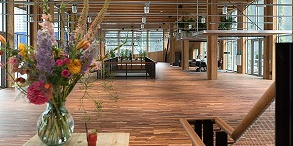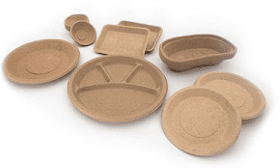Today, new bio-based materials are available everywhere. On the basis of organic materials, they are usually processed with modern chemical techniques. They seem to be able to replace many fossil-based and mineral materials. The following are just a few of these innovations.
1、Natural materials from local resources
A new combination of bio-based materials that has attracted attention was developed by the Colombian company Fiquetex. These materials are made from plants and rubber trees. The plants and trees are native to Colombia. The plant grows in the Andes and the rubber tree originally comes from the Amazon basin. fiquetex's patented nonwoven textile materials are all biodegradable. They can be used in many markets, such as packaging and vegan leather for the automotive and shoe industries.
Alejandro Moreno, the company's founder, has lived in the UK for a long time, where he has witnessed, on the one hand, a lot of debate about the circular economy; but on the other hand, not much has been done about the continuing plastic pollution. He has developed materials produced from local Colombian resources that are sustainable, renewable and most importantly, compostable. His first products include tote bags and the world's first pair of shoes made from 100% natural materials ready for the market.

New bio-based materials were also highlighted by MaterialDistrict, which commonly showcases new materials, including many bio-based materials. Recently, they remembered Herso flooring, made from recycled wood. Even though wood is biodegradable, it can still be wasted. herso uses reclaimed wood to make new products, from furniture to flooring. They use old flooring, furniture, wood cut by carpenters, and of course their own wood, glued together with biodegradable glue. Instead of selling their products, they rent them out - a sustainable program because it allows the company to produce new bio-based materials from discarded materials. Quite comparable is the simulated terrazzo wood flooring produced by Foresso. They reuse discarded wood and use it to create wood and sustainable floors with the look and feel of marble.
2、Berry seeds
Then, there is MOSO, which sells various bamboo products. They say bamboo is considered the fastest growing plant on the planet. Bamboo is incredibly hard: it is many times stronger than oak or the still popular but endangered tropical hardwoods. MOSO uses bamboo in the form of flooring, in various widths, colors and densities. For each market, from domestic to professional. In addition to this, they use bamboo in a variety of products, from walls and panels to outdoor products As well as automotive dashboards and ceilings.

New bio-based materials are produced in large quantities, as evidenced by the annual "Bio-based Material of the Year" competition organized by the NOVA Institute. One of the recent winners is a material consisting mainly of bio-based two-component resins filled with bio-based materials such as coffee grounds, cork, berry seeds or olive leaves, provided by the Belgian company Orineo. Each of these fillers will give the material a different appearance. Another winner was Bio-lutions, a company that produces sustainable packaging and disposable tableware made from agricultural residues. Their technology allows them to use the fibers found in most of these residues around the world. Their goal is to create a decentralized production network that includes local plants and regionalized distribution.
3、New bio-based materials are ubiquitous
Vegan leather is popular among companies developing new bio-based materials. These include Biophilica, a company that developed Treekind, made from tree leaves. Then there is Pinatex, which produces a leather-like material from pineapple leaves used, among other things, in NAE vegan shoes. Rotterdam Fruit Leather produces a leather-like material from old mangoes. On the other hand, Komrads makes shoes from apple leftovers from the apple juice industry.

New bio-based materials are everywhere, just like mycelium, which can be used in many modern object materials, from packaging to construction. Old bio-based materials can be repurposed through modern technology and, like straw, can make excellent building materials. There is also wood, which, if treated industrially in the first place, allows for a great deal of architectural freedom. This could even be used for future high-rise buildings. Bio-based innovation is everywhere. It will have an impact on our building technology and can even be felt in our daily lives.

